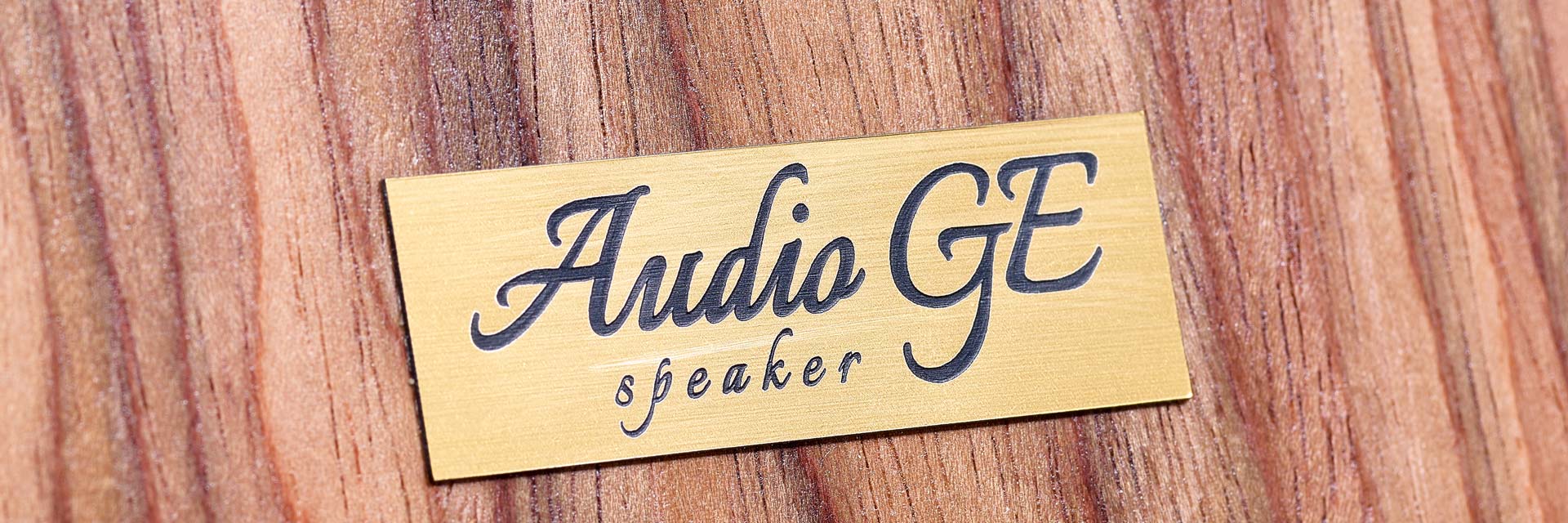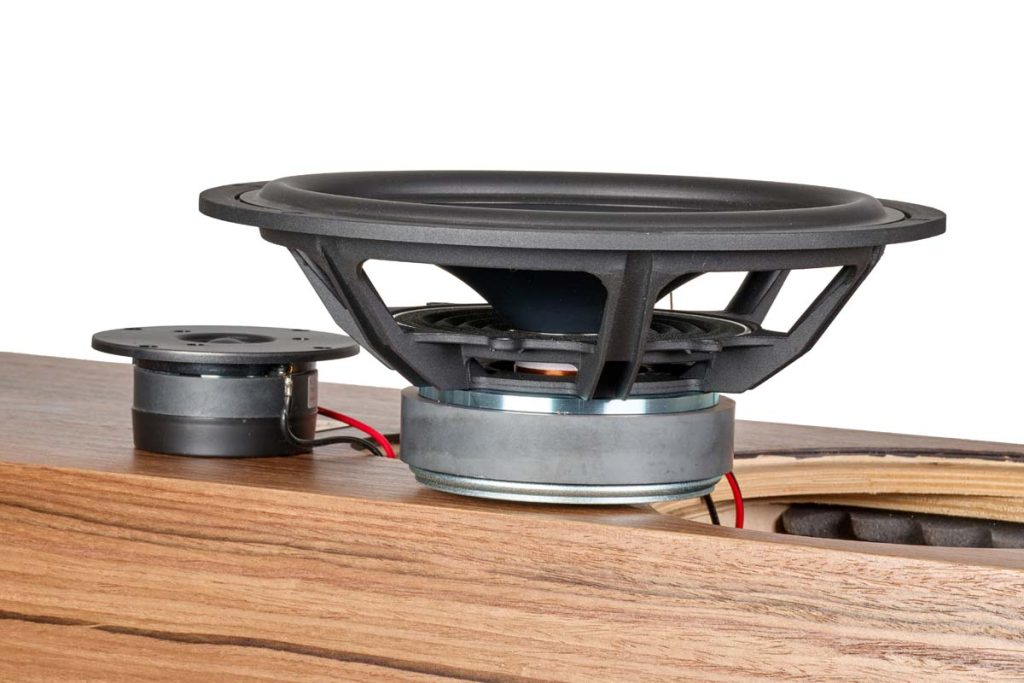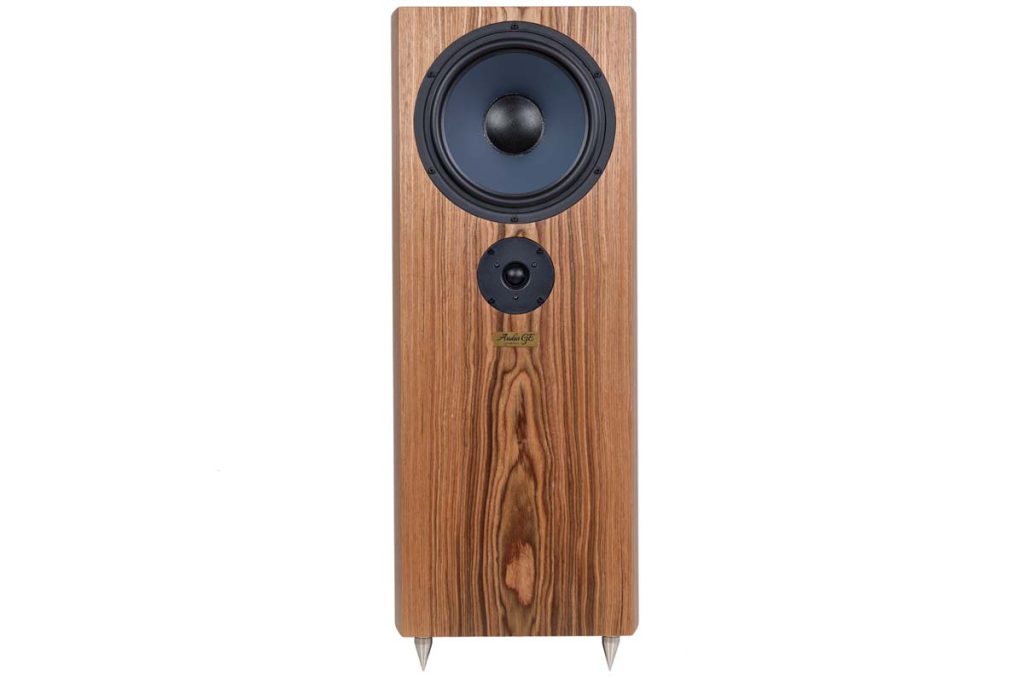Do you know the Teddy? No? This needs to change A.S.A.P. Hiding behind the cuddly name is a downright criminally musical floorstanding loudspeaker – with simple, but well-chosen and applied ingredients, thus producing yet another strength: an extremely tempting price.
Let’s turn the clock back a year. Thorsten Fennel from the distributor The Orange Audio – importer of Albedo speakers, among other things – nudged me towards a manufacturer that was completely unknown in this country and with whom he was still in “loose talks” at the time. I should definitely take a look at the Teddy during my visit to the Audio Video Show in Warsaw and – even more importantly – listen to them. But as it happens, there were 1001 things to discover at the huge show and his request ended up slipping out of my mind. In the evening, as we were chatting about the day’s experiences at the hotel bar, I showed my colleagues a photo of a setup with components that were completely foreign to me, but which completely bowled me over. Of course, you can guess the not particularly surprising plot twist …
It was one of those (unfortunately far too rare) incidents where you are hurrying through the corridors of a hotel trade fair on your way from A to B and suddenly hear a “sound” that pulls you into the room like a high-powered vacuum cleaner. Playing in the room was a waist-high floorstanding speaker with a beautiful veneer, powered by a Rada Valkyrie 36. In case this model designation means nothing to you: it’s an affordable integrated tube amplifier that, like the Teddy, hails from Lithuania. The little team was streaming a track by Dead Can Dance (“The Carnival Is Over”, Into The Labyrinth) and had the room, which measured perhaps 16 square meters, so well under control that you were literally immersed in the music as soon as you entered. What struck me immediately, apart from the great spaciousness and the musicality of the pair, was the incredibly wide, but at the same time razor-sharp and almost uncannily focused imaging of the loudspeaker. And so it was that I was able to declare a system costing just under 5000 euros my personal show highlight – something that doesn’t happen very often these days.
As you can imagine, this kind of prehistory drove my expectations of the Teddy to immeasurable heights. Accordingly, I excitedly plucked the floorstanding speakers out of their boxes when they arrived at the editorial office a few weeks ago. The first surprise came quick: the Teddy seemed so light to me that I carried them into the listening room on my own and without any great effort or technical aids. It later turned out that the speakers weigh 18 kilograms each. However, thanks to its grateful form factor and the huge reflex port at the bottom of the cabinet, the Teddy is so easy to grip that it feels as light as a feather.
The second surprise was less exciting: because it was ready to hand and at operating temperature, I connected the Audio GE to Aavik’s excellent I-580. However, the sound was so tired and lacking in bass that I initially suspected a technical defect. A look at the Teddys’ terminal clarified the situation: these are eight-ohm speakers – and the Aavik doesn’t really seem to cope well with this. A workaround was quickly found: The Line Magnetic LM-88IA (test in FIDELITY No.°69) with dedicated eight-ohm taps happened to be parked in the rack right next to the 580. The tube integrated had barely been switched on when the eye-opening experience from the Warsaw trade fair was repeated. The Teddy suddenly filled our listening room with full bandwidth and marched forward with such energy that we almost felt urged to tie it down.
At this point, let us take a short trip to Lithuania. Behind the products (or rather: the product) of Audio GE is a gentleman by the name of Gediminas Racevicus. The graduate electrical engineer has a family background: His father was a composer, professional pianist and, as a sound engineer, managed the studios of national TV and radio broadcasters. From an early age, Racevicus therefore ended up attending ballet and opera performances almost every week. In other words, he was born with the sound of a big stage in his cradle. Despite his academic background and the possibilities of modern simulation, he found it correspondingly tricky to teach a loudspeaker the “right sound” or authentic stage reproduction.
In essence, this is a hobby project that Racevicus has developed into an increasingly sophisticated product over the course of 20 years. He opted for a two-way design with drivers from ScanSpeak, whose crossover frequency can be controlled comparatively well thanks to fewer components. He mounted the two drivers and his eight-ohm crossover in ever new, increasingly sophisticated cabinet designs. You can’t tell by looking at the Teddy, but inside it is divided into two sections by an angled wooden panel. However, this serves neither to acoustically separate the paths nor to stiffen the cabinet (which it happens to do regardless), but is part of a “quasi-transmission line”, as Thorsten Fennel from Orange Audio distribution explained to me. Of course, there is no such thing as a “half” transmission line, but the partition, which is open on one side, is matched to the geometry and volume of the loudspeaker. And this causes the surprisingly large, downward-radiating bass reflex port to work in a way that is comparable to a “TLine”. The result is an earth-shattering, ludicrously fast 33 Hertz lower cut-off frequency set against a pitch-black background.
The rest of the design can be seen as the antithesis to the ever-increasing complexity of the loudspeaker construction. The 26-centimeter paper cone for bass and mids shares an internal volume with the 2.5-centimeter silk tweeter. As a knock test confirms, the damping and attenuation inside the cabinet are rudimentary at best. The Teddy stands on four feet, each of which is tapered to a point. This effectively dissipates vibrations, but is likely to cause quite a bit of damage to a parquet floor. The terminal is realized with high-quality binding posts. The only other feature worth mentioning are the wonderful real wood veneers ranging from medium to dark brown in which the Teddy is available. The recipe for a fantastic loudspeaker can be that simple when everything is bang on the money.
A word about Audio GE’s product policy: the manufacturer generally only offers one loudspeaker, but it now comes in several versions. Today we are talking exclusively about the Teddy Classic for just under 3000 euros/pair. In response to many requests from dealers and distributors, Gediminas Racevicus has created a luxury version of the speaker, equipping it with high-end drivers and elegant, hand-selected crossover components. Since individual parts and, above all, the selection and tuning by hand are laborious, the Teddy Gold is not only simply a little more expensive, but at 9,000 euros costs three times as much as the original. I cannot make any statements about the sonic benefit, as I have not yet spotted any Teddy Gold in the wild. In between, the engineer designed another model called Teddy Silver, which is technically based on the Gold, but whose cabinet and bass cone are noticeably narrower and smaller – also a request from the sales partners, as not every customer can set up the comparatively bulky Classic. The price: around 7000 euros. I didn’t allow the broadened choice to distract me and wanted to have the exact same speaker in my listening room that had fascinated me so in Warsaw.
And with that, back to Ismaning. I gave the team a week to break in, acclimatize and “get into the groove” – that’s just part of any thorough review. And yet I have to say that the Teddy found its form on the Line Magnetic after just ten minutes. At a blistering 36 degrees Celsius outside temperature, the amplifier and diaphragms obviously don’t need much time to warm up and become supple. Apart from the musically gripping and at the same time incredibly coherent performance of the chain (the expert would speak of phase accuracy), I was also gripped by the extreme soundstaging of the system in our listening room. And I really mean: extreme!
One example that illustrates this impression is Chelsea Wolfe’s “Crazy Love”, which can be found on the album Abyss. The doubled acoustic guitars, beautifully spread across the panorama, are fanned out by the Teddy like a wall. It almost seems as if the stage stretches out over an unbroken semicircle. The voice, with its peculiarly cold, slightly tinny reverb, is in the center, so focused, concentrated and so natural in terms of size that it is almost impossible to relate it to the “wall of sound” of the guitars. Most other speakers – even noticeably more expensive ones – only manage one of the two really well. The Teddy also shows no weakness in terms of microdynamics and voicing: it reveals all the details of Wolfe’s ghostly guitar playing with finesse and transparency, reproducing a full range sound without any coloration. The voice is reproduced clearly and transparently, appearing cold and bright (the recording wants it that way), but without grating or biting.
The Teddy is not entirely plonk-and-play, however: As usual (and because it works well in our listening room), we allowed the small floorstanding speaker plenty of distance from the wall. At least 1.5 meters in each direction. This allows the bass to develop its maximum tightness and precision. However, this is only likely to work in very few living and listening rooms. Thanks to the downfire reflex tube, the Audio GE can be moved closer to the walls with a clear conscience. As expected, this makes the bass a little fuller while only marginally sacrificing fine detail. At around 30 to 40 centimeters, however, the full measure is reached, as then the wide soundstage begins to collapse. You should also refrain from positioning the speakers too far into the corners of the room. Pulling them way out, however, is not a problem at all: as we are talking about a high-precision two-way speaker, the Teddy’s response can be “shaped” almost like with a near-field monitor close to the listening position by varying base width and toe-in. All in all, it’s a transducer that should be worked with and that rewards every bit of effort and care in positioning with greater precision and clarity.
And finally, a word on amplification. Of course, we were not satisfied with the tube. Since it was in the listening room at the time, the Teddy spent some time with Electrocompaniet’s mighty AW 800. The exclusive power amplifier is certainly not the natural playing partner for the inexpensive Lithuanian. But I have to attest that the Teddy did justice to the qualities of the Norwegian. And the Teddy benefited as well: Only in this combination did we become fully aware of the qualities of its ScanSpeak driver in terms of timing and bass definition. In short: this loudspeaker is born for higher things.
Accompanying Equipment
CD player: Audio Note CD 3.1x/II, Ayon CD-3sx | Network player/DAC: Aavik S-580 and D-580, Lumin X1, Cambridge Audio CX-N V2 | Integrated amplifier: Aavik I-580, Line Magnetic LM-88IA | Speakers: Wilson Audio Sasha DAW, Audio Physic Spark, Epos ES14N | Cabling: WestminsterLab, AudioQuest | Racks: Finite Elemente, Solidsteel
Loudspeaker Audio GE Teddy Classic
Concept: 2-way floorstanding loudspeaker with “quasi-transmission line” | Driver complement: 2.5 cm silk tweeter from Jantzen, 26 cm paper cone for low-mid range | Frequency response: 33 Hz to 26 kHz | Sensitivity (2.83 V/1 m): 89 dB | Impedance: 8 Ω | Recommended power: 120 W | Enclosure: bass reflex or “Near-TLine” with downfiring arrangement | Dimensions (W/H/D): 34/90/38 cm | Weight: 19 kg | Warranty period: 2 years | Price per pair: around €3000
The Orange Audio
Thorsten Fennel
Frankfurter Straße 23b
36043 Fulda
Phone +49 6619 3350800
info@orange-audio.de










